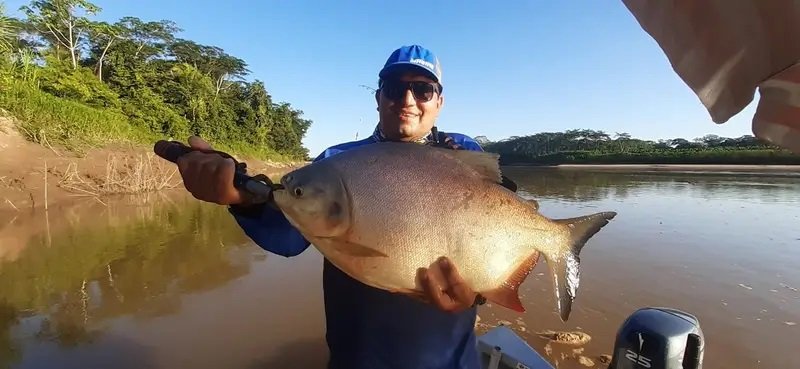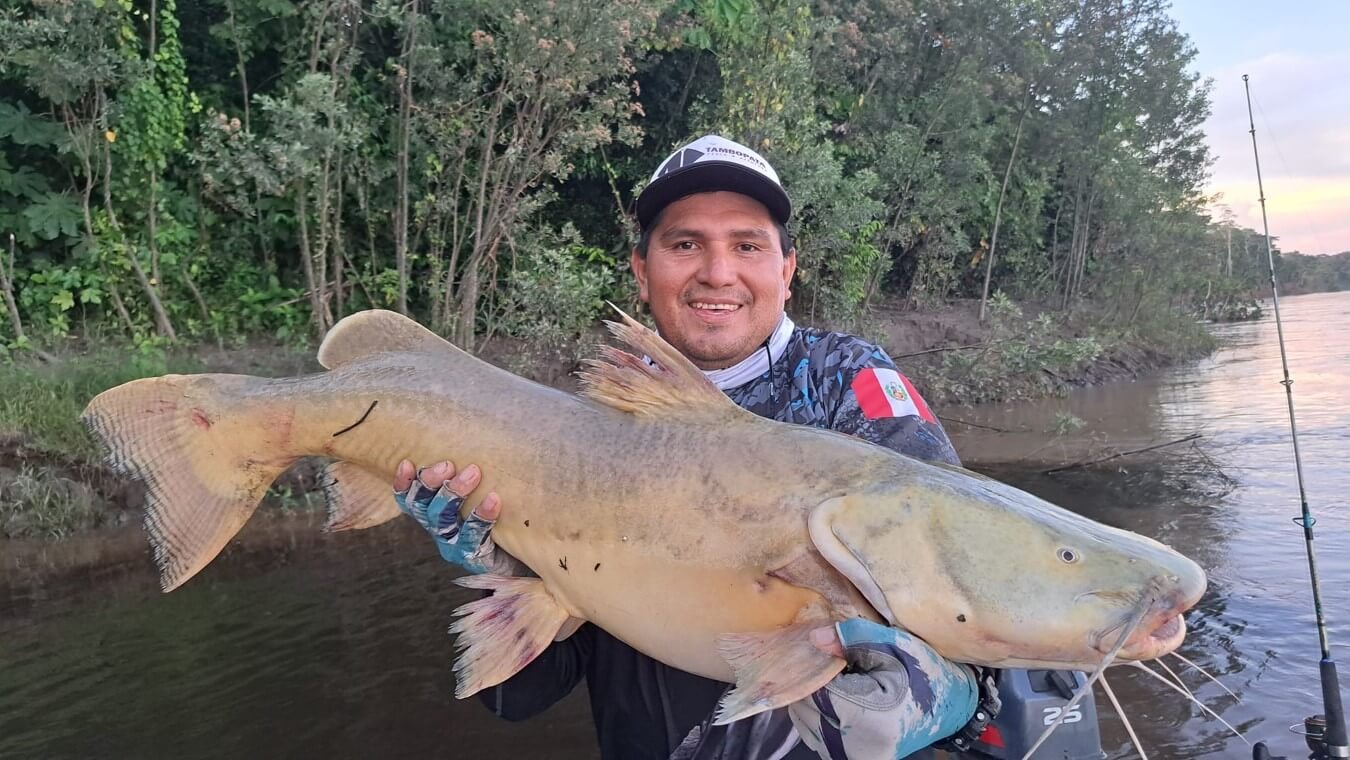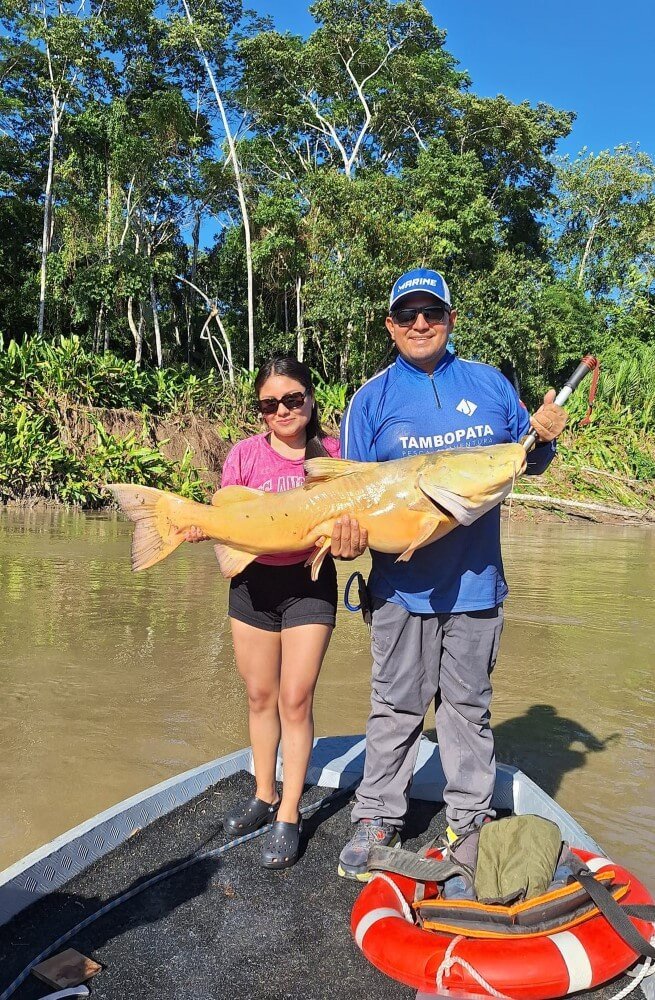Peacock bass fishing in the Bolivian Amazon is not only an exciting sport, but also an opportunity to learn more about this fish’s vital ecological and economic importance. The peacock bass (Cichla monoculus), one of the largest cichlids in the Neotropics, inhabits both clear and white waters of Bolivia’s Amazon basin, particularly the Iténez and Mamoré rivers. Below, we explore its life cycle, differences in aquatic environments, how this affects its reproductive biology, and the best practices for sustainable fishing.

Peacock Bass Distribution in Bolivia
The peacock bass is widely distributed throughout the Bolivian Amazon basin, with a particular abundance in the following rivers:
- Iténez River
- Mamoré River
- Madre de Dios River
- Beni River
- Yata River
Although this species is crucial for sport, commercial, and subsistence fishing, it has been poorly studied in Bolivia, unlike other countries such as Venezuela, where more research has been conducted on the Cichla genus.
Life Cycle of the Peacock Bass in the Bolivian Amazon

The life cycle of the peacock bass is greatly influenced by the type of water it inhabits. Studies conducted in the Iténez and Mamoré rivers revealed significant differences in its reproductive biology, which in turn impact its management and conservation.
Impact of Environmental Conditions
The type of water has a direct effect on key aspects of peacock bass development:
- Iténez River: Females reach sexual maturity at smaller sizes, and reproduction is concentrated mainly in the dry season, extending through the flood season.
- Mamoré River: Here, the reproductive cycle is longer, starting in June and ending in February. Females reach maturity at slightly larger sizes.
These differences highlight how local environmental conditions influence the species’ biological traits and underscore the importance of considering these variations when implementing conservation plans.
Reproductive Periods
- In the Iténez River, reproduction starts in September and intensifies during the dry season, ending in March.
- In the Mamoré River, the reproductive period is longer, beginning in June and finishing in February.
This seasonal pattern is related to daylight length (photoperiod), ensuring that reproduction occurs at the most favorable times for the survival of the fry.
Comparative Study Between the Iténez and Mamoré Rivers
From 2002 to 2004, a comprehensive study was conducted in the Iténez and Mamoré river basins, using advanced methodologies such as otolith analysis to determine the age and growth of individuals. Data were collected at strategic points, including:
- San Ignacio de Moxos
- Isiboro-Sécure National Park (TIPNIS)
- San Martín and San Joaquín rivers
The results showed differences in fecundity and maturity size, with females in the Iténez River reaching maturity at smaller sizes than those in the Mamoré. These findings are essential for the sustainable management of peacock bass fishing in Bolivia.
Importance of Sustainable Sport Fishing
The growing interest in peacock bass sport fishing in Bolivia requires the implementation of conservation practices to protect both this species and its ecosystem. Key recommendations include:
- Catch and release: Allow fish to continue their life cycle after being caught, especially during the breeding season.
- Fishing regulation: Set capture limits and minimum sizes to preserve populations.
- Habitat protection: Avoid river degradation from human activities such as deforestation or pollution.
Effective Techniques for Peacock Bass Fishing
For fishing enthusiasts, the peacock bass represents an exciting challenge. The most common and effective techniques include:
- Artificial lures: These mimic the small fish that make up the peacock bass’s diet, being the most popular technique due to the fish’s aggressive behavior.
- Fly fishing: Particularly effective in clear waters, where visibility is better and allows for greater precision.
It’s essential to use the right gear, such as strong rods and lines, as this fish can put up a tough fight once hooked.
Best Seasons for Peacock Bass Fishing
Peacock bass fishing in Bolivia follows a seasonal pattern depending on the river:
- Iténez River: The best months for fishing are June to September, when the waters are lower.
- Mamoré River: The prime sport fishing season is September to February, after the rainy season.
Planning your trip during these times will significantly increase your chances of catching large specimens.
Findings of the Peacock Bass Study
The study of the peacock bass’s life cycle in Bolivia produced several key conclusions for its conservation:
- Significant ecological variation: Differences in environmental conditions between the Iténez and Mamoré rivers result in variations in the reproductive cycle and growth of the species.
- Sustainable management needed: It is crucial to implement management policies based on an understanding of these local ecological differences to protect peacock bass populations and ensure responsible fishing.
Peacock Bass Fishing Tourism in the Bolivian Amazon

Fishing tourism in Bolivia is on the rise, with peacock bass fishing being one of the most sought-after activities. The reasons for choosing Bolivia include:
- Pristine environments: Untouched rivers surrounded by wild nature.
- Unique biodiversity: In addition to peacock bass, the local fauna includes river dolphins, caimans, and a wide variety of birds.
- Customized packages: Experienced local guides offer tailored excursions, combining fishing with wildlife observation.
Frequently Asked Questions about the Tucunare Fishery in the Bolivian Amazon

1. When is the best season for peacock bass fishing in Bolivia?
The best season varies depending on the river: in the Iténez, it’s June to September; in the Mamoré, it’s September to February.
2. What are the recommended fishing techniques for peacock bass?
The most recommended techniques are using artificial lures and fly fishing, particularly in clear waters.
3. How does water type affect the peacock bass’s life cycle?
Clear waters allow for earlier maturity, while white waters favor longer reproductive cycles.
4. What conservation measures should be taken to protect the peacock bass?
It is essential to practice catch and release, respect breeding seasons, and set capture limits.
5. Are there specialized fishing tours in Bolivia?
Yes, several tour operators offer guided excursions and customized packages for peacock bass fishing in the Bolivian Amazon.

Peacock bass fishing in the Bolivian Amazon is an exciting and rewarding activity, both for sport fishers and those seeking a deeper connection with nature. Not only does it offer the chance to catch one of the Neotropics’ most iconic fish, but it also provides the opportunity to enjoy unparalleled landscapes and contribute to the conservation of this unique species. To ensure its future, adopting sustainable fishing practices is essential to protect both the peacock bass and its Amazonian habitat.





